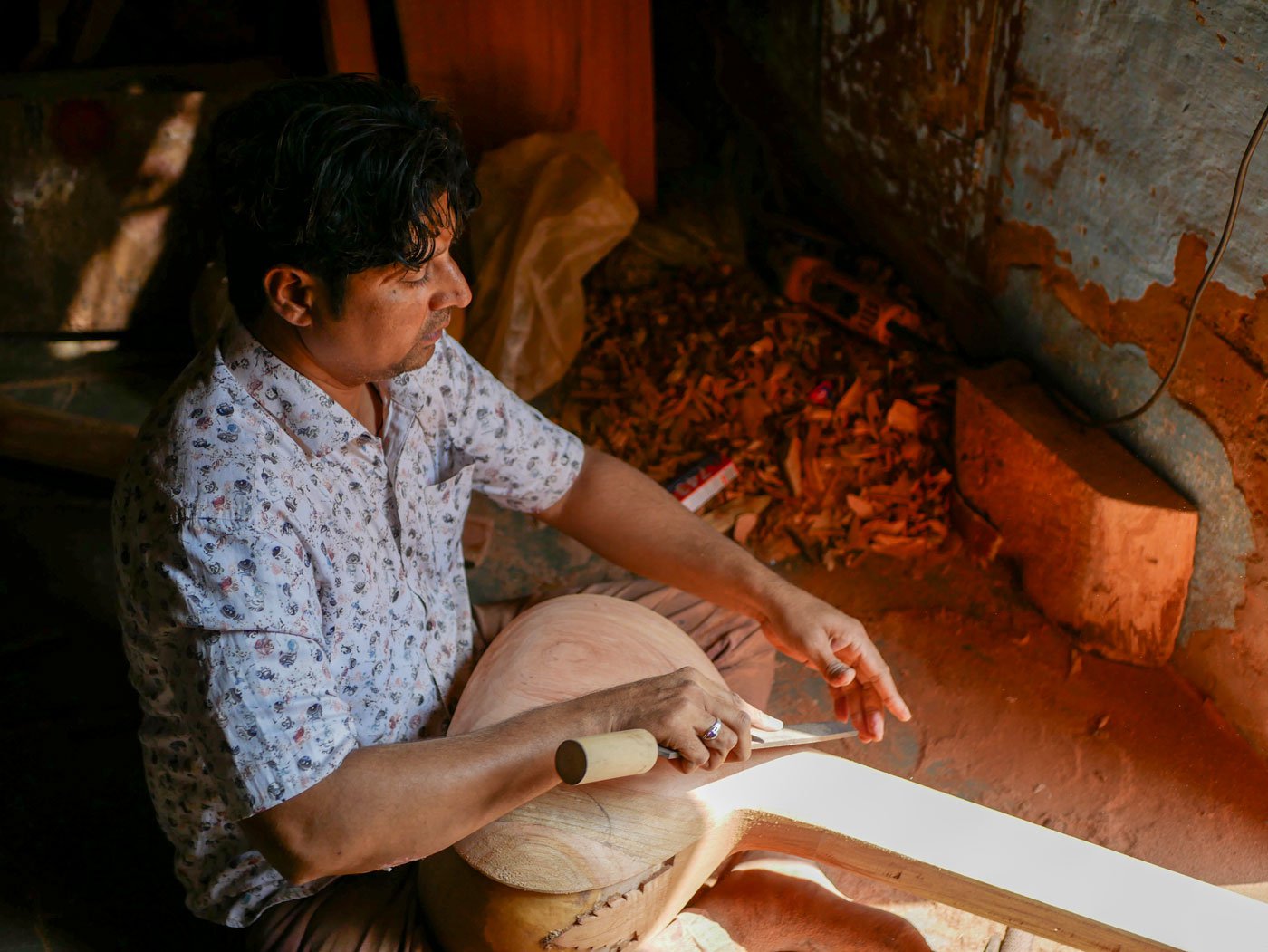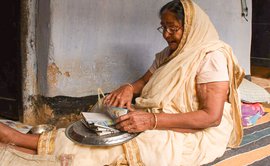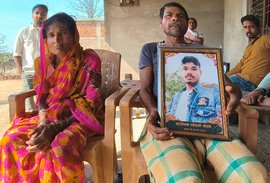Ahemados Sitarmaker could have gone to Paris, but his father did not allow him. “If you see the outside world, you won’t return,” he had said. Recalling those words now, 99-year-old Ahemados’s face breaks into a smile.
When the fifth generation Sitarmaker was in his late 30s, two women from Paris had come to his hometown to learn the craft of making sitars , the classical string instrument. “After asking around, they came to me for help and I started teaching them,” Ahemados says, seated on the ground floor of their two-story house and workshop in Sitarmaker Galli in Miraj, where several generations of his family have lived and worked.
“At the time, we didn’t have a toilet in our house,” continues Ahemados, “we got it made in a day because we couldn’t ask them [the foreign visitors] to go to the fields like we did.” As he speaks, there is a faint sound of a sitar being tuned. His son, Gaus Sitarmaker, is at work.
The two young women stayed with Ahemados’s family for nine months, but their visa expired before they could learn the final steps. A few months later, they invited him to come to Paris to complete the lesson.
But Ahemados stayed home, following his father’s instructions, and continued as an artisan in Sangli district in Maharashtra, a place renowned for the craft. Ahemados’s family have been engaged in this trade for more than 150 years, running into seven generations; at 99, he is still working.
![Left: Bhoplas [gourds] are used to make the base of the sitar. They are hung from the roof to prevent them from catching moisture which will make them unusable.](/media/images/02a-P1230417_PD_SG_Sitarmakers-of-Miraj--f.max-1400x1120.jpg)

Left: Bhoplas [pumpkins] are used to make the base of the sitar. They are hung from the roof to prevent them from catching moisture which will make them unusable. Right: The pumpkin is cut into the desired shape and fitted with wooden sticks to maintain the structure
As in Ahemados’s house-cum-workshop, bhoplas or pumpkins hang from the ceilings of almost every house in this neighbourhood.
Sitarmakers use the bhopla (also called kaddu ) to make the tumba or the base of the sitar . The vegetable is grown in the Pandharpur region, about 130 kilometres from Miraj. The bitterness of the pumpkin makes it unsuitable for consumption and farmers cultivate it for the sole purpose of selling them to the Sitarmakers who craft string instruments. The artisans pre-book the crop in summer to avoid paying more when the crop is harvested in winter. The pumpkins are hung from the ceiling to prevent them from catching moisture from the floor. If left on the floor, the pumpkins develop fungus which hampers the vibrations and life expectancy of the instrument.
“Earlier we paid 200-300 [rupees] per piece, but now it can go up to 1,000 or even 1,500 rupees,” says Imtiyaz Sitarmaker, who cleans and cuts the pumpkin to get the desired shape and size. Rising transportation costs have also contributed to the increase in price. Another problem, says Imtiyaz, is farmers are cultivating less of the pumpkin because of the shrinking demand for handmade instruments – making it more expensive to purchase.
Once the tumba is ready, a wooden handle is fitted to complete the structure. Artisans then begin working on the design, which can take up to a week to complete. Using hand drills and plastic stencils, master designers like Irfan Sitarmaker carve the wood. “Long hours of work in a hunched position leads to back aches and other issues.” says the 48-year-old. “The job takes a toll on the body over the years,” adds his wife Shaheen.“I have nothing against the art or tradition,” says Shaheen Sitarmaker, “I feel proud of the identity which my husband has earned through hard work.” A home-maker and a mother of two, Shaheen also believes that the income from the craft does not justify the physical toll it takes. “We eat based on the daily earnings of my husband. I am happy with life, but we also cannot ignore our necessities,” she says, standing in her kitchen.
Their two sons are learning to play the sitar from their grandfather’s brother. “They play well,” Shaheen says, “in future, they both will make a good name for themselves.”
Some of the Sitarmakers perform only a step in the process, like cutting the pumpkin or creating the design and are paid daily for their work. Designers and painters earn something between Rs. 350–500 depending on the amount and nature of the work. However, there are others to build the sitar from scratch – from washing the bhopla to applying the final coat of polish and tuning the instrument. A handmade sitar costs around Rs. 30–35,000.
The women in the family are generally excluded from the craft. “I assure you, if they start today, my daughters can pick it up in a few days. I am proud that they both have done well in life academically,” says Gaus, a father of two young women. The 55-year-old has been polishing and fitting sitars since his childhood. “Girls will eventually get married. Often they marry into a non sitar -maker family where the skill is useless,” he adds. Occasionally, women polish the pegs or perform some other minor step in the process. But women doing manual work generally attributed to men is frowned upon by the community and they worry it will not be accepted by the groom’s family.

Left: Irfan Sitarmaker carves patterns and roses on the sitar's handle using a hand drill. Right: Wood is stored and left to dry for months, and in some instances years, to season them


Left: Fevicol, a hammer and saws are all the tools needed for the initial steps in the process. Right: Imtiaz Sitarmaker poses with the sitar structure he has made. He is responsible for the first steps of sitar- making
*****
The Sitarmakers made a name for themselves in the business of string instruments in the nineteenth century, during the reign of Shrimant Balasaheb Patwardhan II, the king of Miraj. A patron of music, he invited musicians from other regions such as Agra and Benaras to perform at his court. But on the way, many of the instruments would get damaged and the king had to find repairmen who could solve this problem.
“His search eventually led him to two brothers, Mohinuddin and Faridsaheb, from the Shikalgar community,” says Ibrahim, a sixth generation Sitarmaker. The Shikalgars, listed as Other Backward Classes (OBCs) in the state of Maharashtra, were metalsmiths and made weapons and other tools. “Upon the king’s request,” continues Ibrahim, “they tried their hand at repairing musical instruments; over time, this became their main occupation, and even their name changed from Shikalgar to Sitarmaker.” Today, their descendents in Miraj often use both titles as their last names.
However, more than a historical legacy is needed for the new generation to continue in this trade. Like Shaheen and Irfan’s sons, other children have also started playing the sitar rather than learning how to make them.
As software capable of producing the sounds of various instruments have advanced, musicians have largely turned away from using handmade sitars and tanpuras which has impacted the business. Machine-made sitars , which are priced much lower than the hand-made ones, have also created problems for the Sitarmakers.

Left: Gaus Sitarmaker is setting the metal pegs on the sitar, one of the last steps in the process. The pegs are used to tune the instrument. Right: Japanese steel strings sourced from Mumbai are set on a camel bone clog. These bones are acquired from factories in Uttar Pradesh


Left: Every instrument is hand polished multiple times using surgical spirit. Right: (from left to right) Irfan Abdul Gani Sitarmaker, Shaheen Irfan Sitarmaker, Hameeda Abdul Gani Sitaramker (Irfan’s mother) and Shaheen and Irfan's son Rehaan
To stay afloat, Sitarmakers now make miniature sitars that they sell to tourists. Priced between Rs. 3,000-5,000, these brightly coloured pieces are made with fibre instead of the pumpkin.
Government recognition and aid has been slow to come. Although there are multiple schemes for artists and performers, the people making the instruments are yet to be recognised. “If the government recognises us and our efforts, we can produce even better instruments. It will also help the artists financially and give them a sense that they are respected for their efforts,” says Ibrahim. Veterans like Ahemados, say they have no regrets for dedicating their lives to the craft. “Even today, if you ask me if I want any aid or monetary assistance…I would never want it. Never,” he says.
The internet has opened sales as buyers now directly place orders on the maker's websites, eliminating the commission that store owners and middlemen charge. Most customers are from within the country; international customers have started connecting via the websites.
Watch the video to see how the sitar is made by hand and hear the Sitarmakers speak about the problems they are facing.




